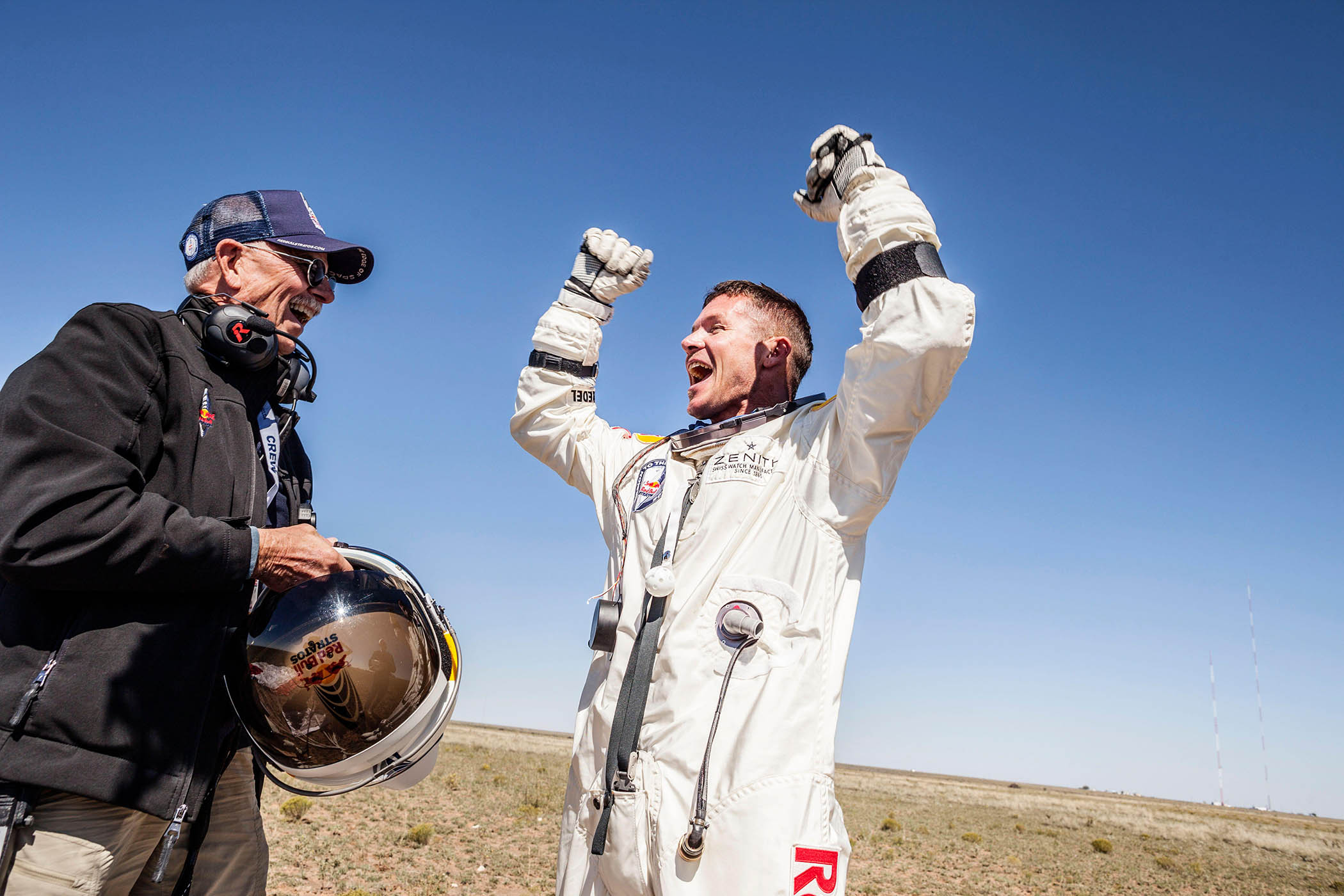At 38,969 metres (127,850ft) above the Earth’s surface, the environment is lethal but the view is stunning. Far beyond the Armstrong line, the point at which atmospheric pressure drops so low that water boils at body temperature, exposure to the airless elements quickly results in death. The full majesty of the planet, however, lies spread out 24 miles beneath you, framed by the infinite blackness of space. It’s a sight that would humble the largest of egos.
This is where Felix Baumgartner, an Austrian daredevil employed by the energy drink corporation Red Bull, was standing 13 years ago to the day on Tuesday. Dressed in a pressurised space suit and helmet, he was teetering at the open hatch of a tiny capsule hoisted into the upper reaches of the stratosphere by a helium-filled polythene balloon, 55 storeys tall and no thicker than a dry-cleaning bag.
No one had achieved anything comparable since the American test pilot Joe Kittinger volunteered for a mission to look at escape routes for astronauts in 1960. Kittinger jumped from 19 miles up and almost perished when a hole appeared in his glove, swelling his hand to twice its size. Six years later, amateur skydiver Nick Piantanida tried to break Kittinger’s record, but at 57,000ft appeared to open his visor, depressurising his suit. There was a scream, the mission was aborted and when his gondola touched down, he was found in a coma. He died four months later.
Baumgartner was well aware of the history, not least because Kittinger had been recruited as his mentor and was speaking to him from mission control. “Attaboy, Felix,” he said, as the Austrian went through his final preparations. His heart rate was at 160bpm as he steadied himself to speak. Unhooked from the capsule’s systems, the only way back was by taking a leap.
“The whole world is watching now and I wish they could see what I can see,” he said, breathing heavily from his suit’s oxygen supply. “Sometimes you have to go up really high to see how small you are. I’m going home now.”
With those words he stepped off the platform and plunged back to Earth, the cameras on the capsule capturing a tiny speck disappearing into the vastness.
The whole world was not watching, but 8 million people on YouTube were – at the time, the largest ever livestream audience – along with an unknown number on various TV stations around the globe. I was among them, and I remember my surprise at how affecting I found the spectacle.
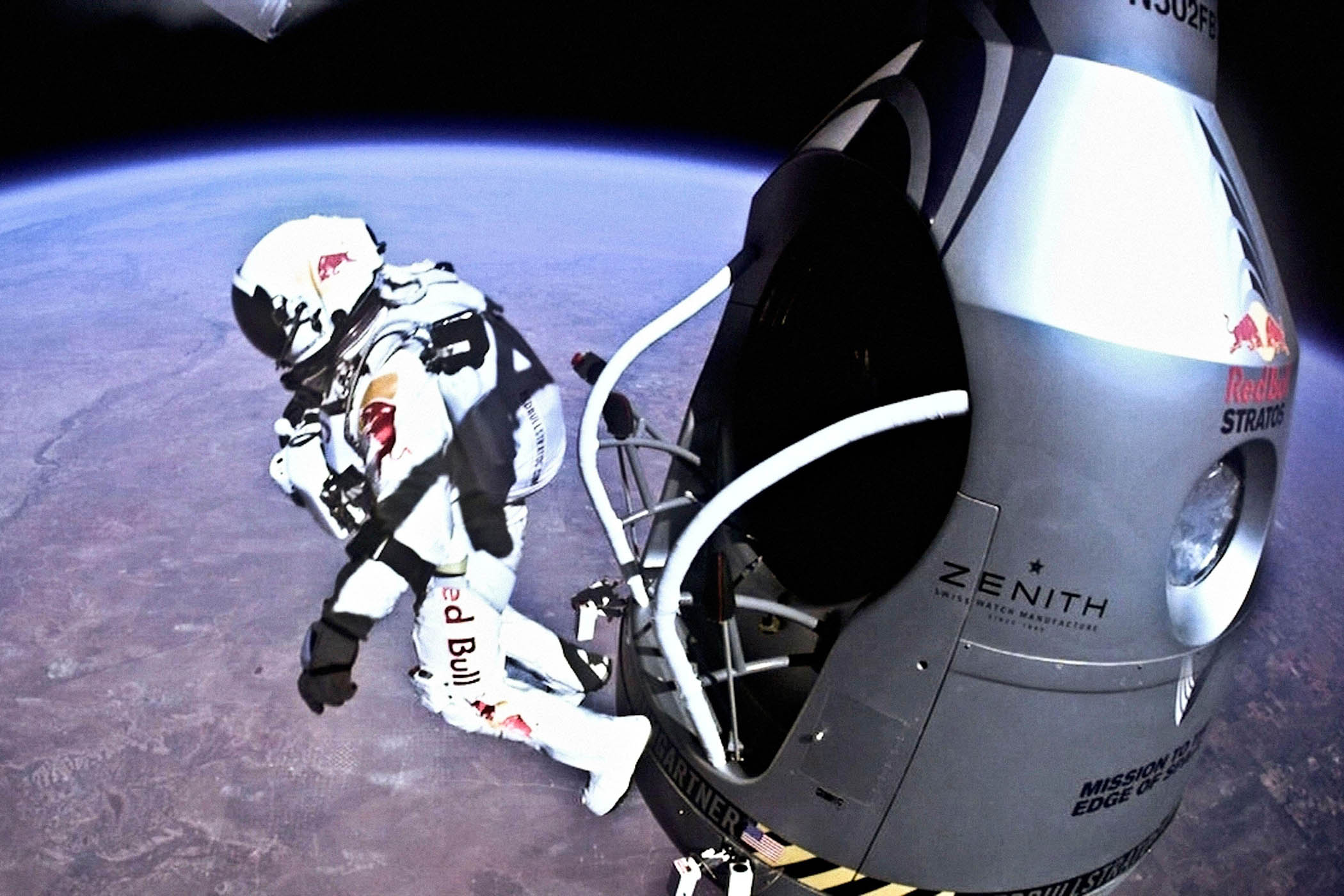
Baumgartner makes his historic jump from 38,969 metres above the Earth in 2014. Main image: He celebrates with support engineer Mike Todd after the flight
Billed as the millennials’ answer to the moonwalks, the Red Bull Stratos mission is estimated to have cost more than £20m and had little practical scientific purpose – although the mission’s technical director, Art Thompson, tells me it advanced the treatment of decompression sickness. It was one giant leap for a man, but a small step for mankind. First and foremost, it was an elaborate piece of corporate branding, the most memorable chapter in the drinks company’s marketing strategy of sponsoring mostly male adventurers who placed themselves in mortal jeopardy.
And yet it was transfixing. I felt moved by the vulnerability of a human falling through the nothingness, but also thrilled by the reckless sense of liberty. With minimal air resistance at that altitude, Baumgartner reached a free-fall speed of 843mph (1,357km/h) within 30 seconds, becoming the first human to break the sound barrier without any form of engine power, and creating a sonic boom that could be heard in the New Mexico desert below. There had been speculation that the reverberations would have a catastrophic physical impact on Baumgartner.
He survived, but no sooner had he broken that record than he went into a flat spin. Without the kind of aerodynamic drag that atmospheric skydivers rely on to manoeuvre, it was extremely difficult for him to stop the gyrations. As the revolutions accelerate, the centrifugal force pushes the blood to the extremities, creating potentially fatal pressure in the head.
As Baumgartner later put it: “There’s only one way for the blood to leave your skull and that’s through the eyeballs. If that happens, you’re gonna die.”
About halfway down, he managed to stabilise himself by turning on to his front. Four minutes and 20 seconds after leaving the capsule, he released his parachute and came to a safe landing not far from Roswell, famed for its sightings of incredible flying objects.
‘Post-orbital remorse’ is the comedown when cosmic heroism is reconciled with the domestic
The successful conclusion of his most ambitious undertaking marked Baumgartner’s retirement from extreme sports. He became a helicopter pilot. But he also swapped the adrenaline of physical danger for that of political controversy, undermining his stellar image with doubt and division.
Before I learned all this, I sometimes wondered what became of the man who fell at supersonic speed to Earth. Then, in July this year, it was reported that Baumgartner had died when his motorised paraglider crashed next to a hotel swimming pool in the Italian Marche. It seemed like a cruelly bathetic ending after such sublime heights.
The 56-year-old was on holiday with his girlfriend, the Monaco-based Romanian TV presenter Mihaela Rădulescu, at the Adriatic resort of Porto Sant’Elpidio. Not for him a book on a sun lounger – but, according to his friend and fellow base jumper Luke Aikins, who worked with him on the Stratos project, Baumgartner was no heedless adrenaline junkie. Aikins once jumped out of an aeroplane without a parachute, diving 25,000ft into a giant net, so he’s familiar with the syndrome.
“I don’t think Felix had anything to prove any more,” he tells me. “He’d pushed the limit and he was taking it easy. Paramotoring is generally a really safe sport.”
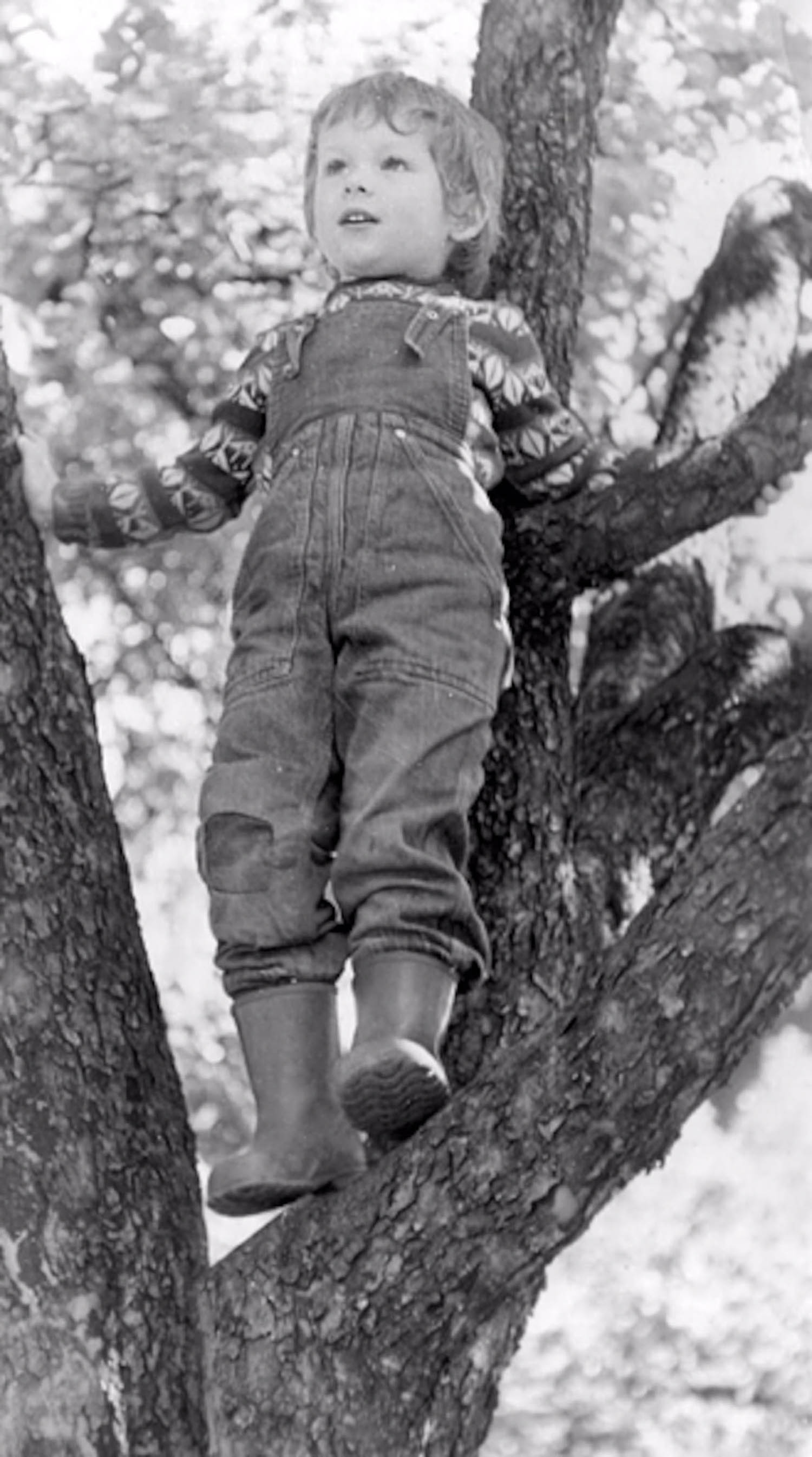
A young Felix Baumgartner, who was raised in Salzburg, Austria
The cause of the crash remains a mystery. Initial reports claimed Baumgartner had suffered a heart attack mid-flight, but that was discounted by an autopsy. A few hours before his death, he posted a photograph on Instagram of a Red Bull windsock flying above his Jeep, writing: “Too much wind.” Last week the investigating prosecutor Raffaele Iannella declared that the accident was the result of human error. “He fell into a spiral,” said Iannella, “and he could not get out.”
With his natural charisma and action hero good looks, a sort of cross between Mark Wahlberg and David Beckham, Baumgartner had revolutionised what had previously been the clandestine business of base jumping. Having trained as a paratrooper in the Austrian military, he began skydiving at Red Bull exhibitions in 1988, when the company and its drink were little known. “In base, he was a creature without precedent,” wrote Matt Higgins in Bird Dream, a chronicle of base jumpers and wingsuit pilots. He was “a figure who profited from high-profile acts that repudiated the jumper’s ethic of ‘leave no trace’ in favour of a ‘look at me’ approach.”
In 1999, with Red Bull sponsorship, he made two record-setting jumps: the highest from a building – the 88-storey 451.9-metre (1,483ft) Petronas Towers in Kuala Lumpur – and the lowest, the 29-metre (95ft) leap from the Christ the Redeemer statue in Rio de Janeiro. He filmed everything, turning it into consumable content long before social media ate up such footage.
“He was one of the first global stars of base jumping,” says Aikins. “He brought it to the public, brought it out of the underground and into the light. Some people liked that, and some people didn’t.”
Although he was nicknamed “Fearless Felix” and wore a “Born to fly” tattoo on his forearm, he was renowned for his meticulous preparation. It took him six years to get ready for the space jump, and three years to do the groundwork for his 2003 crossing of the Channel in a winged suit. “Felix was very calculated. He wasn’t this crazy risk taker. He didn’t do things in a sketchy way,” says Aikins.
In his dedication to reducing risk, no detail, he liked to say, was ever too small.
I’m reminded of this admirable quality as I stand inside the giant transparent doughnut that is Hangar-7, the Red Bull gallery and museum at Salzburg airport. I’ve come to see the micro-capsule from which Baumgartner launched himself in 2012, as well as the pressurised spacesuit in which he plummeted. Contrary to what the internet had led me to believe, neither is here.
Tom Wolfe referred to this malaise as “post-orbital remorse”, the comedown when cosmic heroism has to be reconciled with the domestic and the mundane
“Nein, es ist in Zürich,” an attendant explains. In fact, the capsule and suit, I discover, are on loan to the Swiss Museum of Transport in Lucerne. So much for my meticulous preparation. The good news is that the winged suit in which he flew across the Channel, the stunt that first brought him to international attention, is part of the collection.
It looks like something worn by a mid-ranking superhero from an old cartoon. The carbon-fibre wings have a span of less than 6ft. You wouldn’t fancy crossing the Thames in it, let alone 22 miles of sea at a speed of up to 225mph, from 30,000ft above Dover to landing near Calais. The mannequin sporting the gear is located in an inaccessible spot beneath a ramp that winds upwards to skirt the terrace of Ikarus, a two Michelin-starred restaurant where you can eat Tristan lobster and goose liver for €285.
A tourist stands on the ramp photographing himself looking down on the wingsuited model.
“Were you a fan?” I ask.
“Me?” he replies, as if it’s an accusation. “No, no, no, not a fan.”
After the space jump, Baumgartner became what Austrian investigative reporter Georg Eckelsberger calls a “polarising figure” in his homeland, someone about whom people either had strong opinions or opinions they didn’t wish to share. Beneath his obituary in Austria’s liberal-leaning newspaper Der Standard, readers left scores of polarised comments of a pro or anti nature. A typical example was: “He was a wonderful yardstick – always reliably on the wrong side. You simply knew that the opposite of his opinion was true and right, moral and reasonable.”
Baumgartner’s fall from grace began two weeks after the big jump, when he gave an interview to the Austrian newspaper Kleine Zeitung. He was at the high point of his celebrity, after a triumphant tour of American TV studios. Asked if he would consider moving into politics, he replied: “No, we saw that with Schwarzenegger: you can’t achieve anything in a democracy. We would need a moderate dictatorship, with a few people from the private sector who really know what they’re doing.”
He was far from alone in expressing his frustration with liberal democracy, but few countries have reason to view the word “dictatorship” with more alarm than Austria, birthplace of Hitler and enthusiastic partner in the Anschluss with Nazi Germany. Overnight, Baumgartner became almost as well known for his opinions as for his breathtaking deeds.
When criticised, he cited his belief in freedom of speech. It was as if the lofty perspective he’d experienced demanded a more strident persona.
Jonathan Clark, who was the medical director on the Stratos project, thinks Baumgartner experienced adjustment difficulties. Tom Wolfe, author of The Right Stuff, referred to this malaise as “post-orbital remorse”, the comedown when cosmic heroism has to be reconciled with the domestic and the mundane.
“He was looking for meaning,” Clark tells me. As Nasa’s Space Shuttle surgeon on six shuttle missions, Clark saw many astronauts return to Earth with a thump. Often, the first thing they did was leave their partner. “I used to call it the astronaut ex-wives club,” he says. “Both [astronauts] Mark and Scott Kelly dumped their wives after they came back. Felix broke up with his girlfriend too. We’re all human and that kind of shit happens.”
But coming down from the massive adrenaline rush of space travel, says Clark, can lead to restlessness and depression.
“One guy I know took his own life, others attempted it, and there was a vehicular manslaughter,” he says. “There were weird behavioural outbursts.”
Although Baumgartner at first tried to row back on the “moderate dictatorship” interview, his golden-boy reputation never recovered. A few weeks later, he lost his appeal against a fine for assaulting a Greek truck driver in an earlier traffic dispute; and the following year, in another interview, he praised corporal punishment, which his father had practised, and bemoaned the younger generation’s lack of courage and respect.
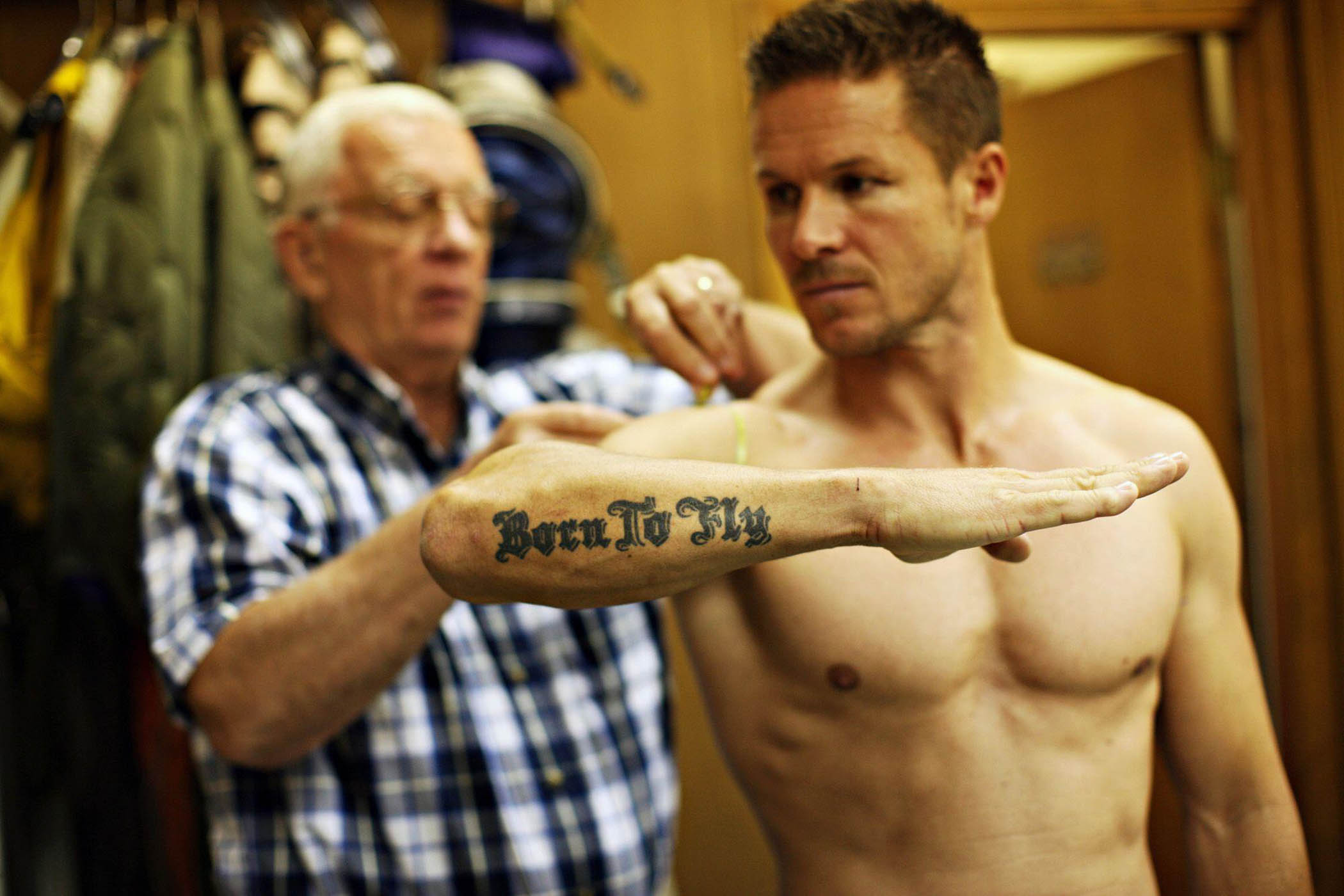
Baumgartner is fitted for his pressure suit by Mike Todd, 2010.
The glamorous trailblazer, who had seemed to embody the very ideal of freedom, was beginning to sound like some old colonel lamenting declining social standards.
He had also relocated to Switzerland for tax purposes – in Austria, he complained, the authorities didn’t recognise him as a legitimate sportsman, which would have qualified him for generous tax breaks. It was reported that his house and helicopter were confiscated by the Austrian authorities in lieu of unpaid tax.
His girlfriend at the time of the space jump was Nicole Öttl, a former gymnast. She sat in mission control, alongside Baumgartner’s mother, watching her boyfriend plummet to Earth. She and Baumgartner split up soon afterwards but, she says, she doesn’t believe the mission affected him in a negative way. The big issue, she thinks, is that he didn’t want to leave Austria, but felt unappreciated and forced out.
She says he was an exacting character but his bugbears, while they were together, were largely apolitical: “It was usually minor things like traffic signs that didn’t make sense or having to wear a helmet when cycling,” she says.
She describes a highly active man who saw himself as something of a rebel, but one with precise ideas about how things should be done.
“I remember nights when he would get out of bed just to adjust the folds of the bedroom curtains so they hung at equal distances, or to move a spice jar exactly one centimetre back into place after dusting,” she says.
It was this kind of attention to detail, she maintains, that enabled him to manage life-threatening risks. Still, something about that positioning of spice jars sounds a little obsessive and controlling. A number of his friends paid testament to his appetite for life and his staunch loyalty, but acknowledged that he wasn’t slow to speak out if he felt something was wrong.
“I wouldn’t say he wasn’t judgmental,” says his friend Helmut Wahl, who was for a time Red Bull’s project lead on the Stratos mission. “You had to be on his level to be respected. There were certain things in his value system that he just wouldn’t accept. But you knew where you were with him. He would never bullshit you.”
The move to Switzerland, says Wahl, meant he no longer had to “filter” himself. “He could say what he wanted to say.”
It also coincided with technological and cultural developments that destabilised politics across the globe, placing many democracies in the political equivalent of a flat spin. The growth of social media polarised opinions, forcing debate towards malevolent extremes. With each new provocative comment Baumgartner made on Twitter, as it was then, or Facebook, he triggered reactions to which he, in turn, reacted, each side marking out more entrenched positions further along the spectrum.
Baumgartner was damning of Austria’s and Germany’s migration policies, as they welcomed large numbers of Syrian refugees. He was critical of legislation to combat climate change. He called for the nationalist Hungarian leader Viktor Orbán to be awarded the Nobel peace prize and, like almost half of voting Austrians, he supported the far-right Freedom party in the 2016 elections. He also spoke positively of Martin Sellner, a former neo-Nazi and the leader of Austria’s Identitarian movement (who would later be associated with the Christchurch mosque mass killer Brenton Tarrant).
Covid saw Baumgartner raise opposition to lockdowns and suggest the Austrian government was more dangerous than the virus because of its enforcement of a vaccination campaign. He was sued for defamation by a pro-vaccination journalist he’d called a “pharma whore”. In the space of a decade he had gone from generational hero to fulminating online culture warrior and conspiracy theorist. He’d achieved all he’d set out to do, and lived a comfortable life between Switzerland and Monaco, so the anger was puzzling. Was he drinking too much Red Bull?
The energy drink that sponsored Baumgartner over several decades is Austria’s most valuable brand and most successful export, estimated to be worth €8.7bn. It was co-founded in 1984 by Dietrich Mateschitz, an Austrian former marketing executive who came across a cane sugar and caffeine drink in Thailand called Krating Daeng, from which Red Bull was later derived. Mateschitz, who died three years ago, was a highly driven but intensely secretive figure – he once threatened an unwanted biographer with the warning: “As long as a kneecapping costs $500 in Moscow, you won’t be safe.” This reluctance to talk seems to be a trait inherited by his company, which did not respond to any of my requests to discuss Baumgartner.
Mateschitz branded his energy drink as being all about speed and maximal experience. “Red Bull gives you wings” is its famous slogan (in 2014 the company paid out $13m to settle a legal suit brought for making false claims about performance enhancement).
Baumgartner was one of the company’s original extreme sportsmen, a small band of adventurers who gained attention for their sponsor by flying – like the Greek legend after whom Hangar-7’s fine-dining restaurant is named – too close to danger. Of the original six that made up Red Bull’s extreme events team in the late 90s, only two now survive.
Two, including Baumgartner, died in situations that were unrelated to Red Bull – though Baumgartner was effectively flying its flag. According to an investigation by the Austrian magazine Dossier, 11 extreme athletes have died at Red Bull events. That’s not a statistic I see anywhere in Hangar-7. Nor is there any mention of Baumgartner’s recent demise in the small display of his Channel-crossing outfit, just details in English and German of the statistics of the record-breaking stunt.
In Baumgartner’s Instagram videos the Red Bull name, logo or the canned drink itself were prominently displayed, and he continued to participate in company events doing acrobatics in a liveried helicopter. I ask in the gift shop if there is anything to commemorate one of the corporation’s longest-standing icons. The saleswoman smiles and shakes her head.
“No,” she says. “We don’t have anything like that.”
In this airy, sunlit space everything is dedicated to the celebration of machines and athletes whose perilous adventures have helped make Red Bull such a global success. But the dark side of that bargain – death – is conspicuously absent.
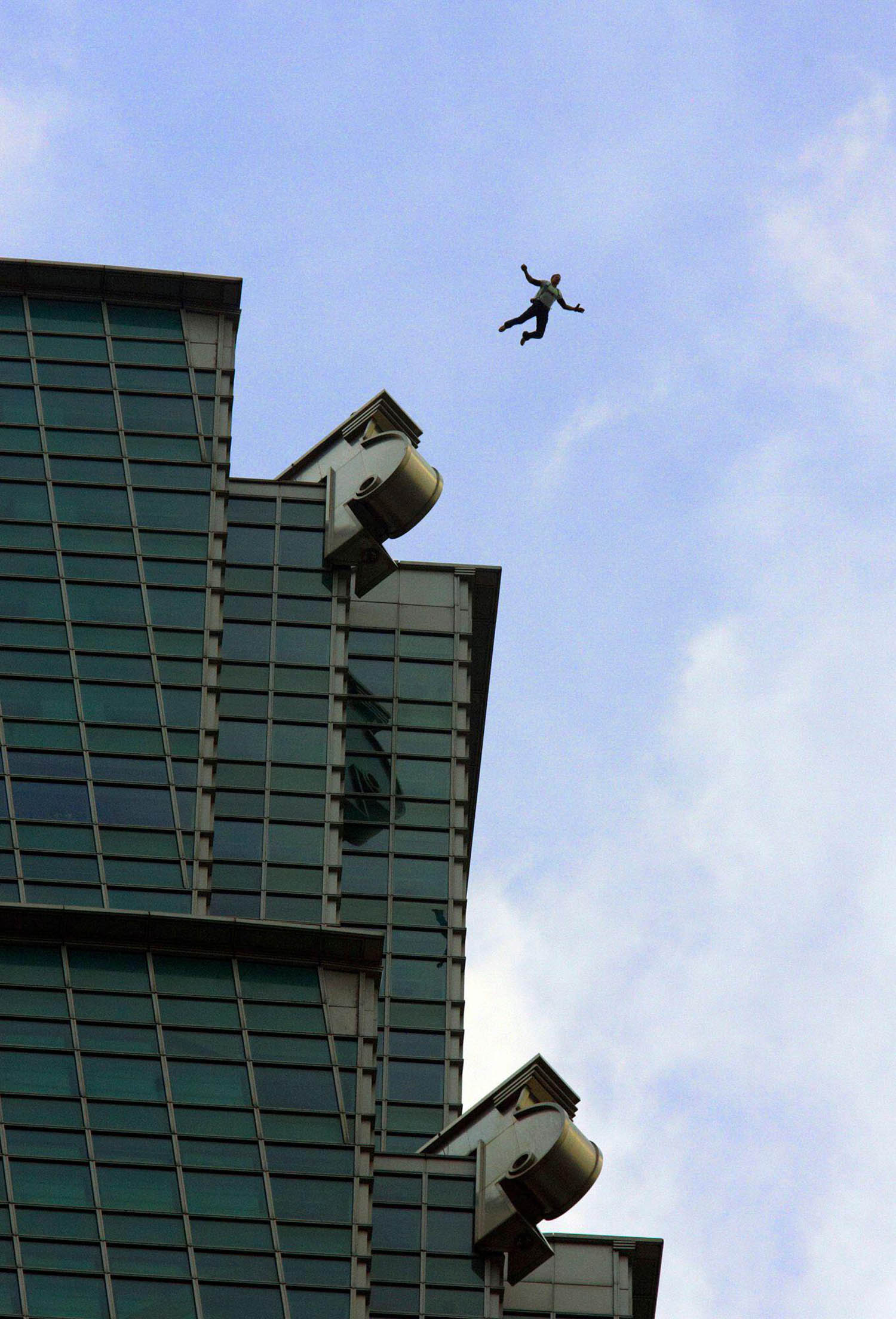
He jumps from the Taipei 101 building, Taiwan, in 2010
Baumgartner, like all the billionaire’s employees, tended to speak of Mateschitz in carefully respectful terms, at least in public. And by all accounts the admiration was genuine and mutual. That mattered when the skydiver suffered a major crisis during the long preparation for the space jump. For all his physical courage in the face of terrifying feats, the Austrian carried an underlying fear: claustrophobia.
He didn’t like the feeling of the space suit, how restrictive it was, and in particular the way the helmet limited his movement and impaired his vision and breathing. Then there was the capsule, barely larger than the seat to which he would be strapped. He would have to sit in the suit in this confined space for almost three hours as the balloon slowly rose. What’s more, he knew that if anything went wrong during the first section of the ascent, the most precarious for the delicate balloon, he would not have enough time to escape and parachute down.
On one of his early test jumps in the space suit, he accidentally cut away his main parachute and then struggled in the unfamiliar outfit to find the spare. He came frighteningly close to crashing into the ground. In another jump, Aikins, who was accompanying him, developed hypoxia from insufficient oxygen in his body tissues, and was unconscious as he fell, only coming round just in time to release his parachute.
Meanwhile there was growing stress within the Stratos team about a series of technical delays. At Baumgartner’s insistence, Red Bull removed his old friend Art Thompson from the position of technical director, only to reappoint him six weeks later when his replacement resigned. Then one day, without warning, Baumgartner walked out on testing and caught the first flight back to Austria.
“Felix called me on video,” recalls Öttl. “I’d never seen him like that before. He was in the airport with tears streaming down his face. He said he wanted to come home. I knew the pressure had got too much for him.”
The disappearance did not go down well at the project base in Lancaster, California.
“It was a team of world-class aerospace engineers and test pilots, people that live and breathe the upper limits of space,” says Michael Gervais, a Californian high-performance psychologist who was brought in to help Baumgartner. “They were very clear that when somebody reaches this type of [paralysing anxiety], they don’t come back.”
The last place you’d want to have a claustrophobic panic attack is 20 miles up in space inside a pressurised suit within a capsule the size of an aeroplane lavatory. Gervais says Baumgartner was strong enough to admit mental frailty in a milieu that was all about the “Right Stuff”, the strength of character displayed by US air force test pilots – Kittinger among them – that Wolfe immortalised.
“People who do not have fear don’t last long in action sports,” he says. “But when you are extraordinary at what you do and everyone’s counting on you, it’s socially unbecoming to show weakness or fear. Felix did not like the moniker ‘Fearless Felix’. Back in 2009, 2010, he raised his hand before most modern athletes acknowledged the importance of psychological health.”
Aikins witnessed the response: “Joe and Art and some of the guys were like, ‘Hey, we need to move on to the next guy.’ Joe was old school. He was in the military and a prisoner of war, a tough guy. But they didn’t realise the fierce loyalty that Red Bull and Mr Mateschitz had to Felix.”
That loyalty was sorely tested as Baumgartner remained in Austria for the better part of a year, while the team continued testing with another pilot in the space suit. It’s probably no coincidence that it was during this period – of what must, to Baumgartner, have seemed like humiliation – that he got into the fight with a Greek truck driver.
Eventually, after some intense work with Gervais and a lot of scuba-diving with Öttl, and to the amazement of the team, Baumgartner felt able to don the suit once more, and to perform in it for up to five and a half hours at a time.
The support Red Bull had given him didn’t stop the skydiver from lashing out in an interview he gave to an Austrian newspaper leading up to the jump date. The pressure he was feeling was evident when he revealed that the ever-opportunistic marketing people at Red Bull had asked him to recite a promotional phrase during the ascent: “Welcome to my world – the world of Red Bull.”
“I told them, ‘Are you stupid or what?’ Imagine [Neil] Armstrong stepping on to the moon and saying that line … It’s a ridiculous idea. I don’t do puppet shows.”
It’s said that Mateschitz was furious at the public disloyalty, but the idea was nonetheless quickly dropped.
To say that the jump went off without a hitch would be an exaggeration. First, one of two balloons was lost, and the flight was postponed for a few days when winds got up just as Baumgartner was about to lift off.
Then, when he did finally take off, he was concerned that his visor was fogging up and that he would have to do the jump blind. The live feed was cut and Aikins brought in to address Baumgartner’s concerns about what to do during the free-fall if he couldn’t see.
Aikins recalls his advice: “I said I would wait until the suit depressurises at about 35,000ft, and then count as slow as you can to 60 and then I’d open my parachute. And he goes, ‘OK, sounds good, thanks.’ It was a sign of the trust that we all had in each other.”
And there was the flat spin – with Baumgartner on his back, seemingly helpless as the whole planet appeared to whizz round beneath him. Kittinger was the only man alive who knew what he was going through on that rapid descent, although the Austrian conveyed some idea after he pulled his parachute at 7,000ft.
“That was really tough,” Baumgartner said, his voice filled with emotion.
“Felix, we’re so proud of you,” replied Kittinger, welling up as mission control erupted in cheers.
When Baumgartner was met on the ground, he looked overwhelmed with relief. “I want to hug the whole fucking world,” he said.
But that man, the one who saw how small he was and who wanted to hug the world, did not last long back on Earth. His friends speak of his humility, generosity, his big heart, intelligence and humour, but such qualities were often reserved for those who knew him. Increasingly in public he was intolerant and mocking. There were many he wanted to slap rather than hug.
“People mistook his confidence for arrogance,” says Wahl, arguing that “his opinions were always based on a lot of research.”
For his critics, that only made them harder to explain. Like many people with strong anti-immigrant views about their homeland, he lived abroad, travelling between Switzerland, Monaco and around the world. The son of a Salzburg carpenter who dreamed of freedom, he rose to the top of his profession through determination. But his success seemed to breed core resentments even as he embraced many of the good things in life.
On the day of his death, according to Art Thompson, Baumgartner wired money to purchase a tractor for a local farmer whose land he used for paramotor takeoffs.
“He did this for the local man to make his life easier,” he says.
His friends attest that, regardless of his illiberal online image, he was full of such acts of kindness.
Rădulescu, Baumgartner’s girlfriend, told Thompson that, contrary to reports, the Austrian was not feeling ill on his final day on Earth. He was in good shape, happy and excited about paramotoring.
“Unfortunately his life was cut short by a drone pilot possibly trying to get a photo of Felix in flight,” says Thompson, citing Rădulescu. “The review of the video footage from the two cameras on Felix showed something coming up into Felix’s face, breaking his nose and knocking him unconscious.”
The prosecutor made no mention of this claim in last week’s inquest statement. There is, though, a kind of symbolic truth to this story. The young boy’s dream of flying took him not just to the skies but up into space. That brought him fulfilment, but also celebrity, then angst and notoriety. Perhaps it wasn’t ascending too high that caused the fatal blow, but instead the destructive forces that followed behind.
Photographs by Zuma Press Inc/Alamy/Red Bull Content Pool
